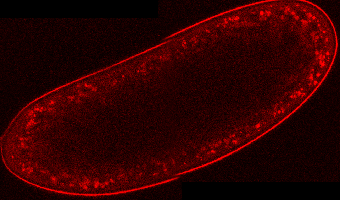Diffusion in crowded media
We are interested in diffusion processes in crowded media, and in particular in cells. One recurring quesion in our studies is how diffusion processes can lead to pattern formation, cellular polarization, and cellular differentiation.
What is diffusion?
Diffusion describes the random movement of particles due to collision with other molecules. For example, the diffusion of molecules in a solution is due to collision with the solvent molecules. Diffusion is a thermal effect, characterized by a mean-squared displacement that scales linearly with time ( <r2(t)> ~ t ).
Why and how does crowding influence diffusion?
As environments become more crowded, molecules are no longer simpy colliding with themselves or solvent molecules, but now also with obstacles. This can effectively promote or hinder diffusion, making the motion much harder to accurately predict and follow. Diffusion in these environments is usually slower than in the absence of obstacles, but it also becomes stranger. For example, it can become anomalous, where <r2(t)> ~ tα (where usually α < 1) which means that diffusion becomes slower when observed at larger length scales.
What are examples of crowded media?
The interior of a cell is a good example of a complex crowded media. There is up to 400g/l of proteins present in the cytoplasm of cells. Other examples of crowded media include gel, polymer solutions, colloidal solutions and fractal media.
What cellular processes are influenced by diffusion?
Because thermal energy (kT) is of the same order of magnitude as other types of energies (chemical, electrostatic, mechanical...) relevant to the motion and folding of proteins, all proteins undergo diffusion. Therefore all cellular processes employing soluble proteins must be influenced by diffusion. Examples include signalling processes, gradient formation, and the search of transcription factors for their target genes.
How can we measure diffusion in cells?
Different methods can be used to study diffusion processes. In our lab, we primarily use fluoresence fluctuation methods, but also fluoresence recovery after photobleaching (FRAP) and single particle tracking.
What kind of questions are addressed in the lab?
First we are looking at the length-scale dependence of diffusion in crowded media. Second, we are looking at how diffusion of nuclear transport factors and morphogens can lead to the formation of spatial patterns in cells, as illustrated in the movie below.
Drosophila melanogaster embryo expressing both a Bcd-EGFP fusion protein and a Nup-mRFP fusion protein.
Below left: The Bicoid protein is synthesized at the anterior pole and then diffuses through the embryo. Because it carries a nuclear localization signal, it accumulates in nuclei during interphase.
Below right: The Nup-mRFP is a marker of the nuclear envelope. (credit: Chris Cabral)


Publications
- Abu-Arish, A., Porcher, A., Czerwonka, A., Dostatni, N., Fradin, C. (2010). Fast mobility of Bicoid captured by fluorescence correlation spectroscopy: Implication for the rapid establishment of its gradient. Biophysical Journal, 99(4), L3-L4. doi:10.1016/j.bpj.2010.05.031 [Read]
- Porcher, A., Abu-Arish, A., Huart, S., Roelens, B., Fradin C., Dostatni, N. (2010). The time to measure positional information: maternal Hunchback is required for the synchrony of the Bicoid transcriptional response at the onset of zygotic transcription. Development, 137(16), 2795-2804. doi:10.1242/dev.051300 [Read]
- Abu-Arish, A., Ng-Kamstra, J., Kalab, P., Weis K., Fradin, C. (2009). Spatial distribution and mobility of the protein Ran in live interphase cells. Biophysical Journal, 97(8), 2164-78. doi:10.1016/j.bpj.2009.07.055 [Read]
- Banks, D. S., Fradin, C. (2005). Anomalous diffusion of proteins due to molecular crowding, Biophysical Journal, 89(5):2960-2971. doi:10.1529/biophysj.104.051078 [Read]
- Fradin, C., Zbaida, D., Elbaum, M. (2005). Dissociation of nuclear import cargo complexes by the protein Ran: a fluorescence correlation spectroscopy study. Comptes Rendus Biologies, 328(12), 1073-1082. doi:10.1016/j.crvi.2005.10.003 [Read]
- Banks, D. S., Montazeri, A., Fradin, C. (2004). Influence of the cellular environment on the diffusion of macromolecules, Physics in Canada, 60(2), 131-139.
- Fradin, C., Abu-Arish, A., Granek, R., Elbaum, M. (2003). Fluorescence correlation spectroscopy close to a fluctuating membrane. Biophysical Journal, 84 2005-2020. doi:10.1016/S0006-3495(03)75009-7 [Read]

